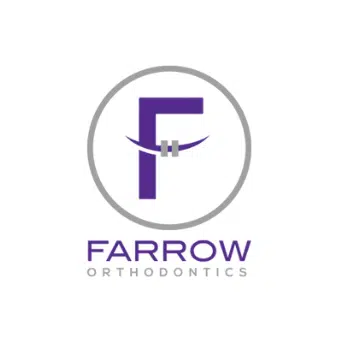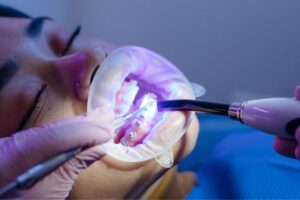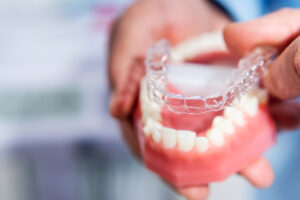Orthodontic treatment for sleep apnea is a growing alternative to traditional therapies like CPAP machines. Sleep apnea disrupts breathing during sleep, often due to airway blockages caused by jaw misalignment or narrow dental arches. Many people struggle with constant fatigue, headaches, and other health risks without realizing their teeth and jaw structure may be part of the problem. Orthodontic solutions can help by improving airflow and making breathing easier.
Addressing sleep apnea is more than just stopping snoring. It’s about protecting long-term health. Left untreated, this condition can increase the risk of heart disease, stroke, and high blood pressure. For those looking for a non-invasive, long-term solution, orthodontic care provides an effective way to improve sleep quality and overall well-being.
What Is Sleep Apnea and Why Is It a Serious Health Concern?
Types of Sleep Apnea
There are different forms of sleep apnea, and each affects breathing in unique ways:
- Obstructive Sleep Apnea (OSA): The most common type, caused by airway blockages during sleep.
- Central Sleep Apnea: A brain-related issue where the brain fails to signal the muscles that control breathing.
- Complex Sleep Apnea: A combination of obstructive and central sleep apnea.
Symptoms to Watch For
Many people experience symptoms for years without realizing they have sleep apnea. Common signs include:
- Loud snoring, often accompanied by gasping for air
- Pauses in breathing while sleeping
- Waking up feeling tired despite sleeping for several hours
- Frequent headaches, dry mouth, or sore throat in the morning
- Daytime fatigue and trouble concentrating
These symptoms don’t just affect sleep. They can impact daily life, work performance, and overall health.
Who Is at Risk?
Sleep apnea can affect anyone, but some factors increase the likelihood of developing it:
- A naturally small airway or recessed jaw
- Misaligned teeth or an overbite that affects airflow
- Excess weight, which can contribute to airway collapse
- A family history of sleep apnea
- Smoking, alcohol use, or nasal congestion that worsens breathing difficulties
Recognizing these risk factors is the first step toward finding the right solution. Orthodontic treatment for sleep apnea provides an option that targets the root cause rather than just managing symptoms.
How Orthodontic Treatment for Sleep Apnea Works
Orthodontic treatment for sleep apnea focuses on correcting jaw alignment and improving airflow. Many cases of sleep apnea occur because the airway becomes restricted during sleep. Misaligned teeth, a small lower jaw, or a narrow palate can contribute to this problem. By adjusting the position of the jaw and teeth, orthodontic care helps create more space for proper breathing.
How Orthodontic Treatments Address Sleep Apnea
Unlike CPAP machines, which force air through the airway, orthodontic solutions work by reshaping oral structures to allow natural airflow. These treatments help by:
- Expanding the airway to reduce blockages
- Shifting the jaw forward to prevent obstruction
- Correcting misalignment that contributes to breathing difficulties
- Providing a long-term solution instead of nightly equipment use
Key Orthodontic Approaches Used in Treatment
Different orthodontic methods are available depending on the severity of sleep apnea and the patient’s dental structure.
- Mandibular Advancement Devices (MADs): These custom oral appliances reposition the lower jaw slightly forward, keeping the airway open during sleep.
- Palatal Expanders: Often used in younger patients, these devices widen the upper jaw, creating more room in the nasal and oral airways.
- Braces and Aligners: Straightening teeth and adjusting bite alignment can help reduce airway restrictions.
- Surgical Orthodontic Interventions: In severe cases, jaw surgery may be recommended to reposition the bones and create a larger airway.
Each of these treatments is designed to address the underlying cause of sleep apnea rather than just controlling symptoms. Consulting with an orthodontist can help determine the most effective approach based on individual needs.
Benefits of Orthodontic Treatment for Sleep Apnea
Choosing orthodontic treatment for sleep apnea provides more than just relief from snoring. It offers long-term improvements in breathing, sleep quality, and overall health. Unlike CPAP therapy, which requires ongoing use, orthodontic care focuses on correcting the problem at its source.
Improved Breathing and Oxygen Flow
A restricted airway makes it harder for the body to get enough oxygen during sleep. By correcting jaw position and widening the airway, orthodontic treatment improves airflow. This leads to fewer breathing interruptions and better oxygen distribution throughout the body.
Better Sleep Quality
People with sleep apnea often wake up multiple times during the night without realizing it. These disruptions prevent deep, restful sleep. Orthodontic care helps eliminate obstructions, allowing for uninterrupted sleep cycles. Many patients notice increased energy, improved focus, and fewer headaches after treatment.
Reduced Health Risks
Untreated sleep apnea has been linked to serious health problems, including:
- High blood pressure
- Heart disease and stroke
- Type 2 diabetes
- Chronic fatigue and mood disorders
By addressing airway blockages early, orthodontic solutions help lower these risks and promote long-term wellness.
Long-Term, Non-Invasive Solution
Unlike CPAP machines, which require nightly use and regular maintenance, orthodontic treatment provides lasting results. Once the teeth and jaw are properly aligned, many patients experience permanent improvements in breathing and sleep without needing additional devices.
Who Can Benefit from Orthodontic Treatment for Sleep Apnea?
Orthodontic treatment for sleep apnea is not just for severe cases. Many people with mild to moderate symptoms can see significant improvements with the right approach. Understanding who may benefit can help determine if this treatment is a good option.
Adults and Children with Sleep Apnea Symptoms
- Those who snore regularly or experience interrupted breathing during sleep
- Individuals who wake up feeling unrested despite a full night’s sleep
- Children with narrow palates or dental misalignment that affects breathing
People with Jaw Misalignment or Small Airways
- Individuals with a recessed lower jaw or an overbite that contributes to airway obstruction
- Those with a narrow palate that restricts airflow through the nose and mouth
- Patients whose orthodontic issues lead to chronic mouth breathing
Those Seeking Alternatives to CPAP Therapy
- People who struggle with CPAP discomfort, mask leaks, or difficulty using the machine consistently
- Those looking for a permanent solution instead of relying on nightly equipment
- Patients who want a treatment option that doesn’t require ongoing maintenance
Patients with Chronic Snoring Issues
- Individuals whose snoring disrupts their own sleep or their partner’s
- Those experiencing dry mouth, sore throat, or frequent nighttime awakenings
- People who have been diagnosed with mild sleep apnea and want to prevent it from worsening
By addressing the underlying causes of airway obstruction, orthodontic treatment can provide lasting relief for many individuals struggling with sleep apnea symptoms.
Comparing Orthodontic Treatment to Other Sleep Apnea Solutions
Sleep apnea can be managed in several ways, but not all treatments address the root cause. Orthodontic treatment for sleep apnea offers a non-invasive, long-term solution compared to other options like CPAP machines or surgery. Understanding the differences can help in choosing the most effective approach.
CPAP Therapy vs. Orthodontics
CPAP (Continuous Positive Airway Pressure) therapy is one of the most common treatments for sleep apnea, but it comes with challenges.
- CPAP therapy requires nightly use, while orthodontic treatment works to correct airway issues permanently.
- Many people struggle with CPAP discomfort, including mask irritation, dry mouth, and difficulty sleeping with the machine.
- CPAP machines require ongoing maintenance, including cleaning and replacing parts. Orthodontic treatment, once completed, does not require lifelong upkeep.
While CPAP therapy is effective, it only manages symptoms. Orthodontic care works toward a long-term solution by reshaping oral structures to improve airflow.
Surgery vs. Orthodontic Treatment
For severe sleep apnea, some patients may consider surgical procedures to widen the airway. These include:
- Uvulopalatopharyngoplasty (UPPP): Removes excess tissue from the throat to open the airway.
- Maxillomandibular Advancement Surgery (MMA): Repositions the upper and lower jaw to increase airway space.
- Nasal Surgery: Corrects structural issues like a deviated septum.
While surgery can be effective, it comes with risks such as infection, prolonged recovery time, and the possibility of recurrence. Orthodontic treatment provides a less invasive alternative that gradually improves airway function without the risks of surgery.
For those looking for a solution that enhances natural breathing without ongoing equipment use or surgical intervention, orthodontic treatment offers a promising option.
How to Get Started with Orthodontic Treatment for Sleep Apnea
Orthodontic treatment for sleep apnea requires a personalized approach based on the severity of symptoms and dental structure. The process begins with a professional evaluation and continues with a customized treatment plan to ensure the best results.
Consultation with an Orthodontist or Sleep Specialist
- A sleep study may be recommended to confirm the presence of sleep apnea.
- An orthodontist will assess jaw alignment, dental structure, and airway space.
- Discussion of treatment options based on individual needs and severity.
Dental Imaging and Evaluation
- X-rays and 3D scans help determine how the jaw and teeth impact airflow.
- Orthodontists analyze bite alignment and any structural obstructions.
- A thorough examination ensures the most effective treatment approach.
Customized Treatment Plan
- The orthodontist will recommend the best method, such as mandibular advancement devices, palatal expanders, or braces.
- The treatment timeline varies depending on the severity of misalignment.
- Patients receive guidance on how the device or treatment will work to improve breathing.
Regular Follow-Ups for Adjustments
- Orthodontic treatments require periodic check-ins to monitor progress.
- Adjustments may be needed to ensure proper airway expansion.
- Long-term results depend on consistency in treatment and follow-up care.
Starting orthodontic treatment for sleep apnea is a step toward better sleep and improved health. A consultation with a professional can determine the most effective solution for long-term relief.
Frequently Asked Questions (FAQs)
1. Can orthodontic treatment completely cure sleep apnea?
Orthodontic treatment can significantly reduce or eliminate sleep apnea symptoms for many patients, especially those with jaw misalignment or airway restrictions. However, the effectiveness depends on the severity of the condition. In some cases, a combination of treatments may be needed.
2. How long does orthodontic treatment for sleep apnea take?
The timeline varies based on the treatment method and the severity of the misalignment. Some patients see improvements within a few months, while others may need treatment for one to two years. Regular follow-ups ensure progress and proper adjustments.
3. Is this treatment suitable for all ages?
Yes, both children and adults can benefit from orthodontic treatment. Early intervention in children can prevent more severe airway issues later in life, while adults with mild to moderate sleep apnea can see lasting improvements with orthodontic adjustments.
4. Does insurance cover orthodontic treatment for sleep apnea?
Coverage depends on the insurance provider and the diagnosis. If sleep apnea is diagnosed through a sleep study, some medical insurance plans may cover a portion of the treatment. It’s best to check with both medical and dental insurance providers for details.
5. Are orthodontic devices more comfortable than CPAP machines?
Many patients find oral appliances like mandibular advancement devices more comfortable than CPAP masks. These appliances are custom-fitted and allow for natural breathing without the noise or maintenance of a CPAP machine.
For those considering orthodontic treatment for sleep apnea, consulting a specialist is the best way to determine the most effective option for long-term relief.
Conclusion: Take Control of Your Sleep and Health
Sleep apnea can have a serious impact on daily life and long-term health, but treatment options are available. Orthodontic treatment for sleep apnea provides a non-invasive, long-term solution by correcting jaw and teeth alignment to improve airflow. Unlike CPAP machines that only manage symptoms, orthodontic care works to address the root cause of airway obstruction.
Better sleep means better health. By improving breathing, reducing sleep disruptions, and lowering the risks associated with untreated sleep apnea, orthodontic solutions can make a lasting difference. Consulting an orthodontist is the first step in finding the right approach for lasting relief.
If sleep apnea symptoms are affecting your quality of life, consider scheduling a consultation to explore how orthodontic treatment can help. A professional evaluation can determine the best solution for improving sleep and overall well-being.
Take the Next Step Toward Better Sleep and Health
If sleep apnea is affecting your rest and daily life, orthodontic treatment could be the key to lasting relief. Farrow Orthodontics provides advanced, patient-focused care to help improve breathing, sleep quality, and overall well-being.
Led by Dr. Anthony Farrow, our team offers comprehensive orthodontic solutions for children, teens, and adults. From Invisalign to traditional braces, we use the latest technology to create comfortable and effective treatments. Every patient receives a customized approach designed to fit their needs.
Get started with a consultation to explore your options. Contact Farrow Orthodontics today and take the first step toward better sleep and a healthier future.



